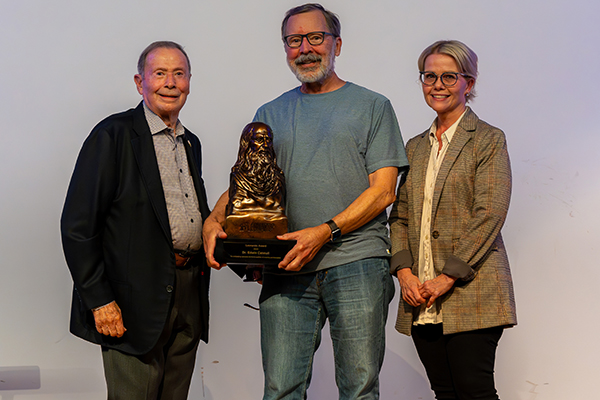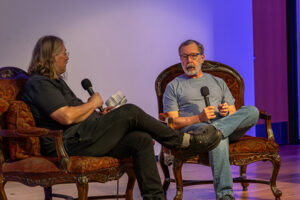Engineer. Inventor. Studio president. Academy Award winner. Turing Award winner. Computer graphics pioneer.
Ed Catmull, Price Engineering alumnus, co-founder of Pixar Animation Studios and former president of Pixar and Walt Disney Animation Studios, now has another title to add to his collection.
The Leonardo, the Salt Lake City museum that blends art and science, has now honored Catmull with their annual Leonardo Award.
Catmull was introduced by Virginia Pearce, Director of the Utah Film Commission, who highlighted his lasting contributions to the medium. John Price, Price Engineering alumnus and namesake, then presented Catmull with the award and honored his lifetime of achievement.

“If The Leonardo is the modern manifestation of Leonardo da Vinci’s vision and interdisciplinary innovation,” says the museum’s nomination, “then no one person better embodies the shared ethos of da Vinci, and his institutional namesake, than Ed Catmull.”
But of all the titles that Ed Catmull has acquired over his illustrious career, “alumnus” still stands out.
“This is a very special place,” said Catmull. “I came away with the belief that, wherever I went, this was the kind of environment I wanted.”
Catmull made those remarks during a celebration of an IEEE Milestone, an honor from engineering’s largest scholarly society marking his and his colleagues pioneering work in the field of computer graphics. It is no exaggeration to say that this research literally changed the way we see the world; if it’s displayed on a screen, it almost certainly relies in part on Catmull and company’s foundational work in how we represent three-dimensional objects in digital spaces.
That research would also launch Catmull’s own career to the heights of Hollywood, as it led directly to the creation of Pixar, the studio that revolutionized 3D animated film. But before helping create the worlds of Toy Story and Monsters Inc., Catmull had to go to school.
When Catmull first joined the U in 1963, he was interested in studying physics. History had other ideas; a revolution in computer graphics was happening all around him, and Catmull began taking computer science classes to join the exciting new field. It was there he would meet and collaborate with the likes of Jim Clark, Martin Newell, Alan Kay, and Henry Fuchs, all fellow honorees of the IEEE Milestone.
Catmull would go on to produce his first landmark film in 1972, during his doctoral studies in the nascent Department of Computer Science. Only a few seconds long and consisting entirely of a 3D rendering of his left hand flexing, Catmull’s debut lacked the narrative flair that Pixar would later be known for, but it was nevertheless a groundbreaking moment for the art form.

It would not be long before the entertainment industry took notice. In 1979, George Lucas hired Catmull to head the computer animation division for Lucasfilm. It was there that Catmull began working on the computer animation software known as RenderMan, which would go on to be the core program used in the development of Pixar’s animated films.
In addition to multiple technical Oscars, the creation of RenderMan was honored with its own IEEE Milestone earlier this year; the software was cited for having “revolutionized photorealistic rendering, significantly advancing the creation of 3D computer animation and visual effects.”
Catmull created Pixar with Steve Jobs after Apple purchased Lucasfilm’s computer animation division in 1986. Though it would be nearly a decade before they released their first feature-length 3D animated film — Toy Story — the accelerating pace of research in the field would soon after turn the studio into a juggernaut. Pixar would go on to release another 27 feature films over the next three decades, totaling nearly $17 billion at the box office.
That acceleration shows no sign of stopping, which is why Catmull is also an honorary chair of the Campaign Committee for the John and Marcia Computing and Engineering Building.
“There is an intense, worldwide competition for computer science talent, especially in a world of rapid technological change” says Catmull. “In order to attract and keep the best, we need a world-class environment for them to learn and grow”
The new building, the College’s most ambitious project to date at $194 million, is slated for completion in 2026. Once occupied, it will embody Catmull’s spirit of curiosity and creativity as well as foundational research. It’s that lens that will focus the power of new computational fields on academic disciplines across campus.